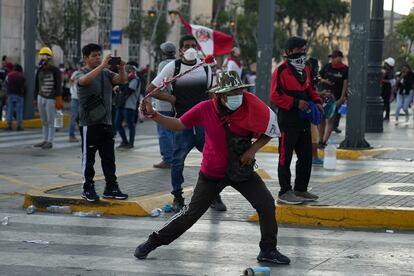Peru protesters tear-gassed after president calls for ‘national truce’
Nearly 7,000 officers were stationed in the center of Lima, where student and worker demonstrations descended into clashes with the police

Thousands of protesters took to the streets of Peru’s capital and were met with volleys of tear gas amid clashes with security forces just hours after President Dina Boluarte called for a “national truce” after almost two months of protests.
The antigovernment protest Tuesday was the largest – and most violent – since last Thursday, when large groups of people, many from remote Andean regions, streamed into Lima to demand Boluarte’s resignation, immediate elections and the dissolution of Congress.
The city witnessed a massive exchange of tear gas, stones, sticks and paint. The police had been anticipating it, which is why there were 6,800 officers guarding the center of the capital, where most of the demonstrations have been taking place. This is where the presidential palace, Congress, the seat of the judiciary and other institutions are located – institutions that the Peruvian demonstrators no longer believe in. Since early Tuesday, a group of tanks was watching over Abancay Avenue, one of the main arteries of the capital.
At midday, President Boluarte had called for a “national truce” and apologized to the families of the more than 50 people killed since the protests broke out following Pedro Castillo’s failed self-coup on December 7. However, at the same time Boluarte remarked that the protests are being “whipped up by radical groups that have a political and economic agenda based on drug trafficking, illegal mining and smuggling.” Her words were met with more protests.
Under the slogan “University students from all over Peru, united” several groups of students from public universities converged on Plaza Dos de Mayo at 4pm together with grassroots members of the General Confederation of Peruvian Workers (CGTP) labor union and reservists of the Armed Forces. After cheering each other on with panpipes and drums, the protest headed towards Congress.
Unlike previous days, this time the police repressed the demonstrators more harshly. An as yet unspecified number of people ended up with leg and facial injuries, including reporters, demonstrators, volunteer nurses and police officers.
The clashes spread along Wilson Avenue. At one point, hundreds of people were trapped in a street section called Lampa, as riot officers hurled gas canisters at both ends of the street, leaving protesters with no possibility of escape.
As of the last report by the Ombudsman’s Office, on the peak day of protests in the capital, road blockades, strikes and mobilizations were registered in 39 provinces, around 20% of the total number in Peru. On Wednesday, Boluarte was scheduled to offer explanations before the Permanent Commission of the Organization of American States (OAS).
Before last week, most of the large antigovernment protests that followed the ouster of President Castillo had taken place in remote regions of Peru, largely in the country’s south, exposing deep divisions between residents of the capital and the long-neglected countryside.
The crisis that has sparked Peru’s worst political violence in more than two decades began when Castillo, Peru’s first leader from a rural Andean background, tried to short-circuit the third impeachment proceeding of his young administration by ordering Congress dissolved on December 7. Lawmakers impeached him instead, the national police arrested him before he could find sanctuary and Boluarte, who was his vice president, was sworn in.
Sign up for our weekly newsletter to get more English-language news coverage from EL PAÍS USA Edition
Tu suscripción se está usando en otro dispositivo
¿Quieres añadir otro usuario a tu suscripción?
Si continúas leyendo en este dispositivo, no se podrá leer en el otro.
FlechaTu suscripción se está usando en otro dispositivo y solo puedes acceder a EL PAÍS desde un dispositivo a la vez.
Si quieres compartir tu cuenta, cambia tu suscripción a la modalidad Premium, así podrás añadir otro usuario. Cada uno accederá con su propia cuenta de email, lo que os permitirá personalizar vuestra experiencia en EL PAÍS.
¿Tienes una suscripción de empresa? Accede aquí para contratar más cuentas.
En el caso de no saber quién está usando tu cuenta, te recomendamos cambiar tu contraseña aquí.
Si decides continuar compartiendo tu cuenta, este mensaje se mostrará en tu dispositivo y en el de la otra persona que está usando tu cuenta de forma indefinida, afectando a tu experiencia de lectura. Puedes consultar aquí los términos y condiciones de la suscripción digital.
More information
Archived In
Últimas noticias
Trump claims peace in Ukraine is near, but Moscow suggests otherwise
A survivor’s account of the Interoceanic Train accident: ‘We were scared because of the speed on the curve’
The Interoceanic Train, the Mexican alternative to the Panama Canal
What is known about the Interoceanic Train derailment in Oaxaca
Most viewed
- Oona Chaplin: ‘I told James Cameron that I was living in a treehouse and starting a permaculture project with a friend’
- Reinhard Genzel, Nobel laureate in physics: ‘One-minute videos will never give you the truth’
- Why the price of coffee has skyrocketed: from Brazilian plantations to specialty coffee houses
- Pablo Escobar’s hippos: A serious environmental problem, 40 years on
- Chevy Chase, the beloved comedian who was a monster off camera: ‘Not everyone hated him, just the people who’ve worked with him’










































